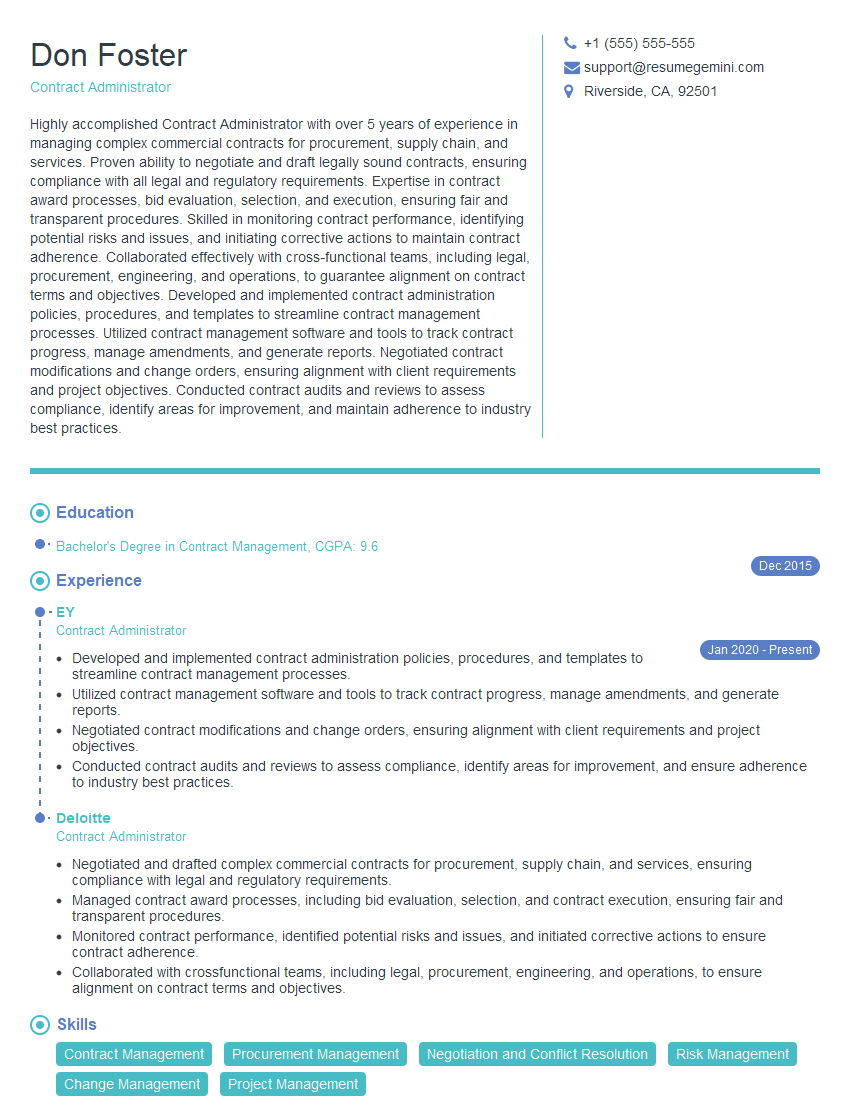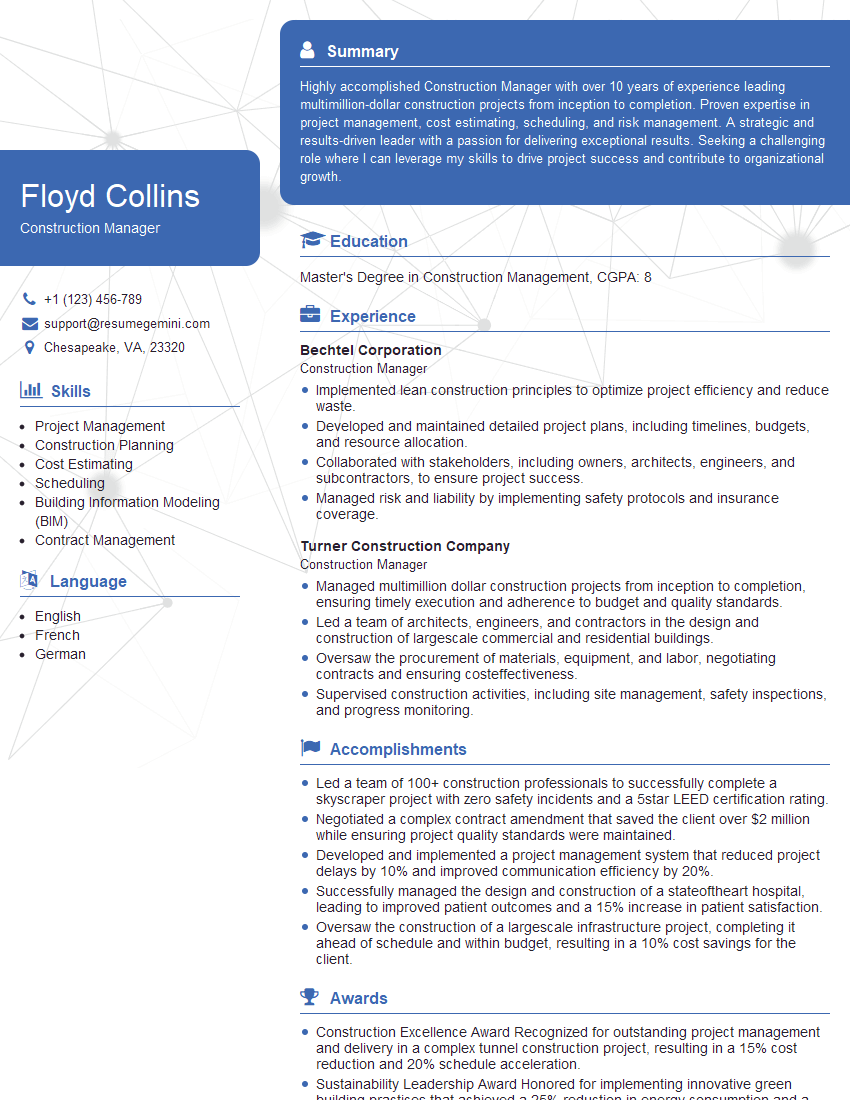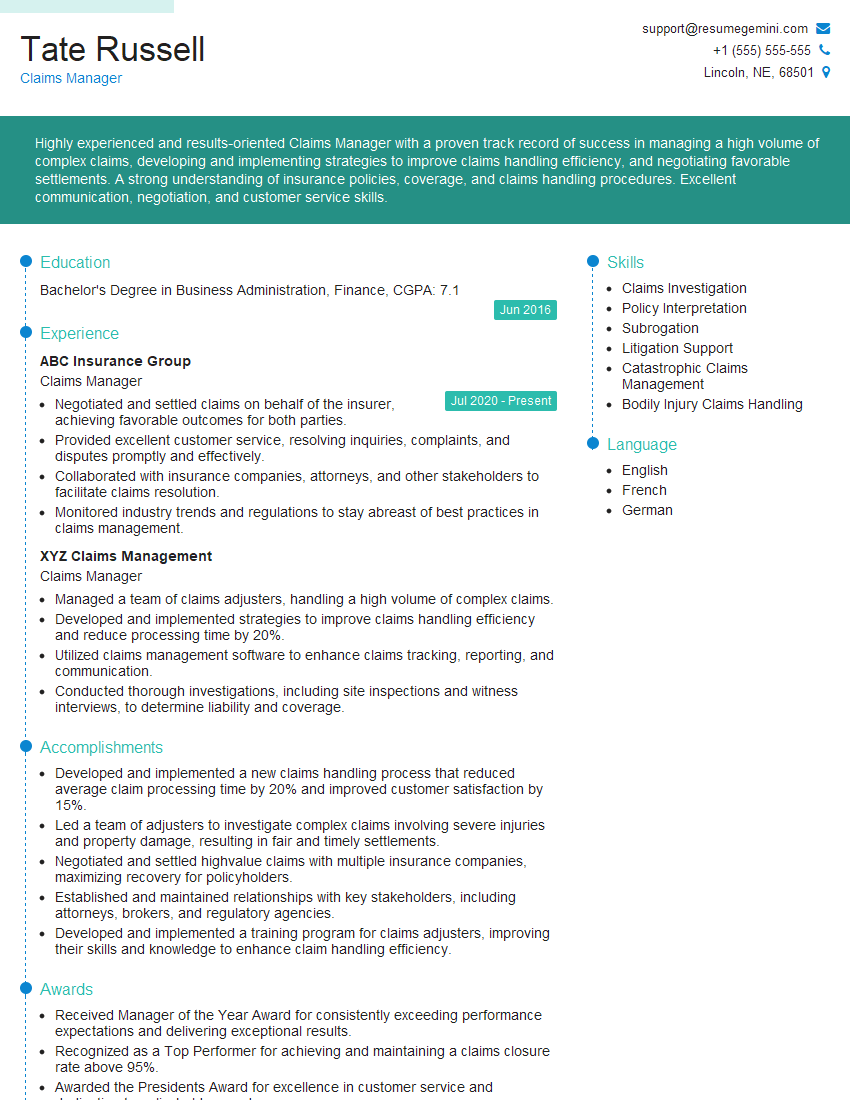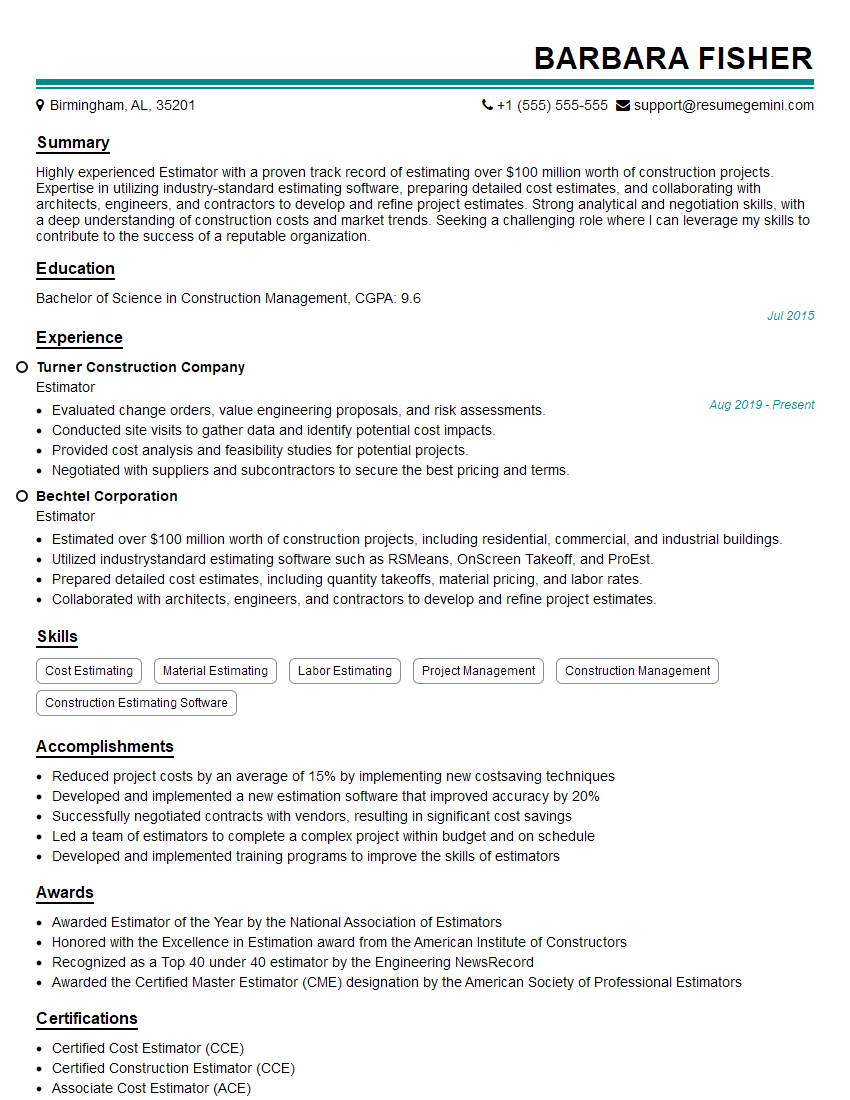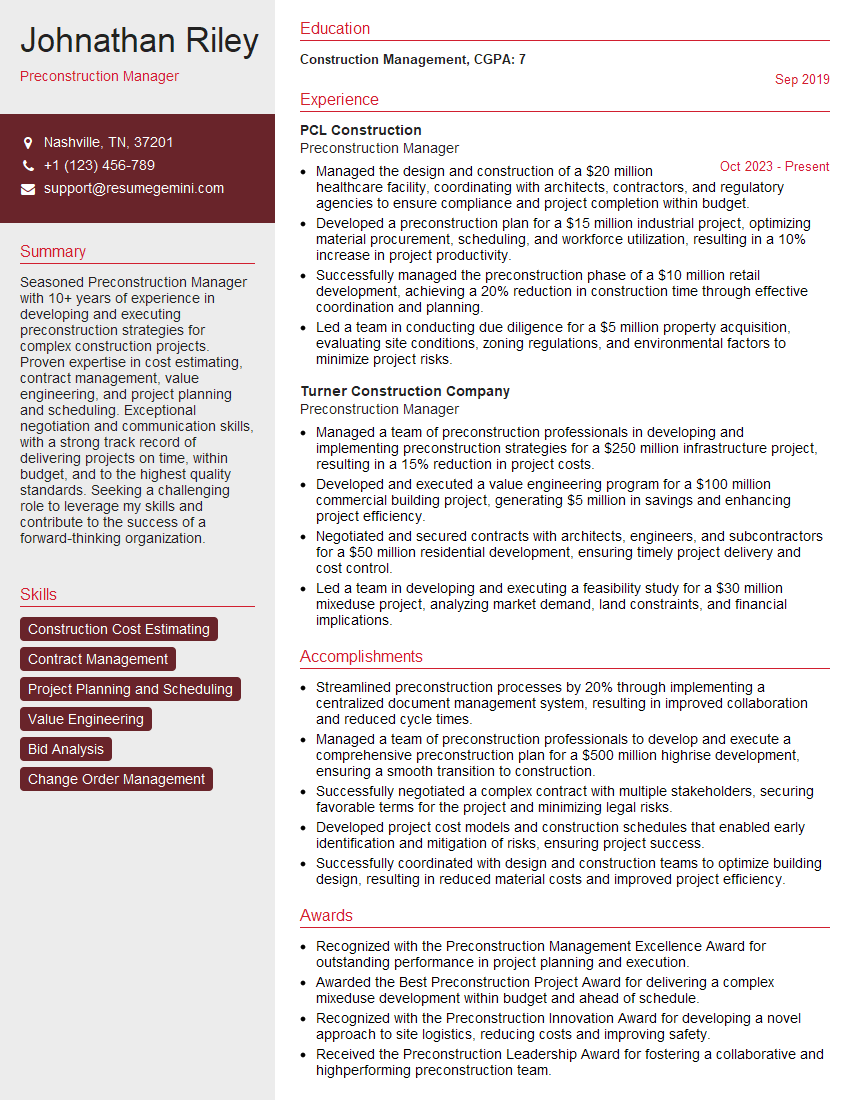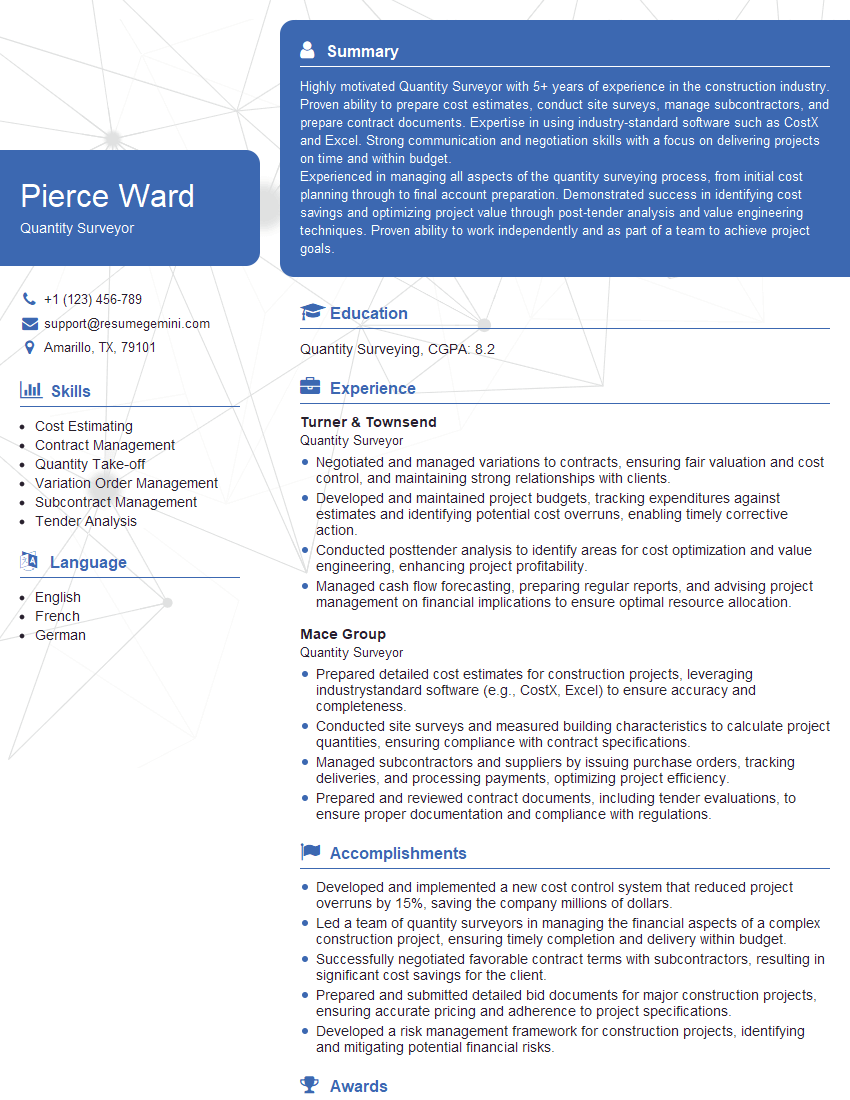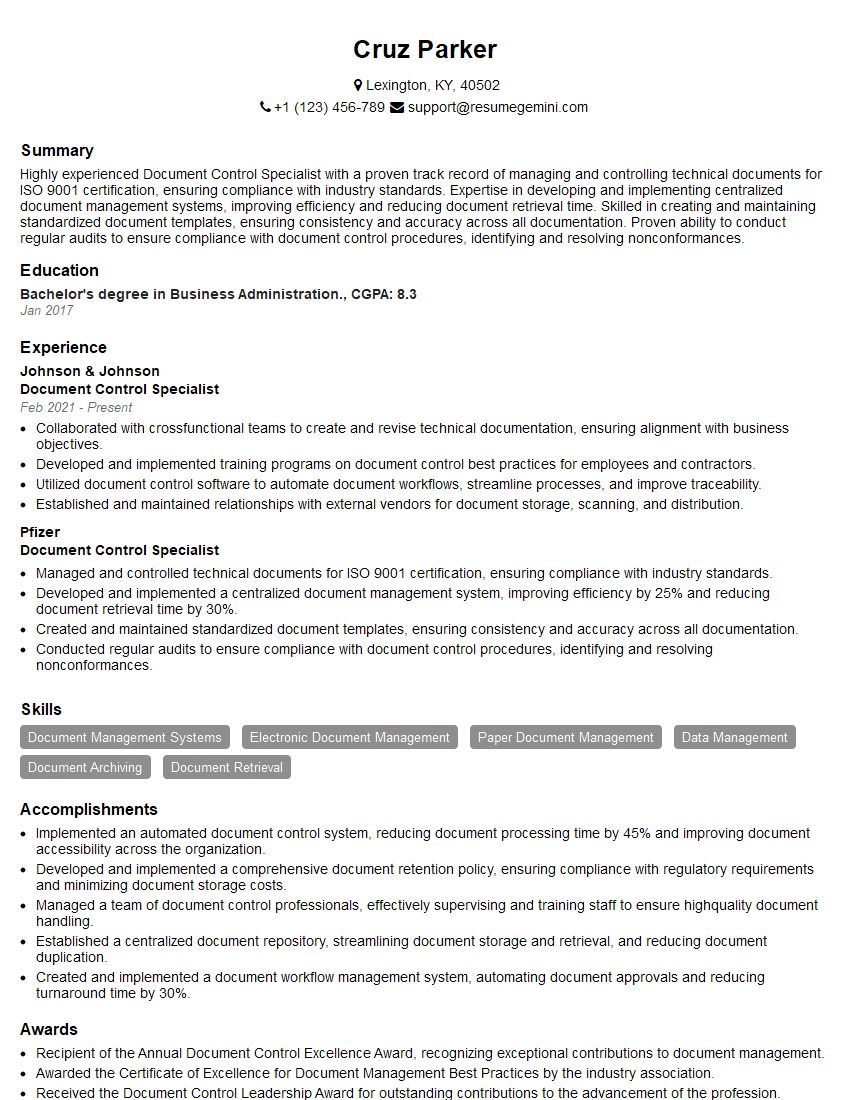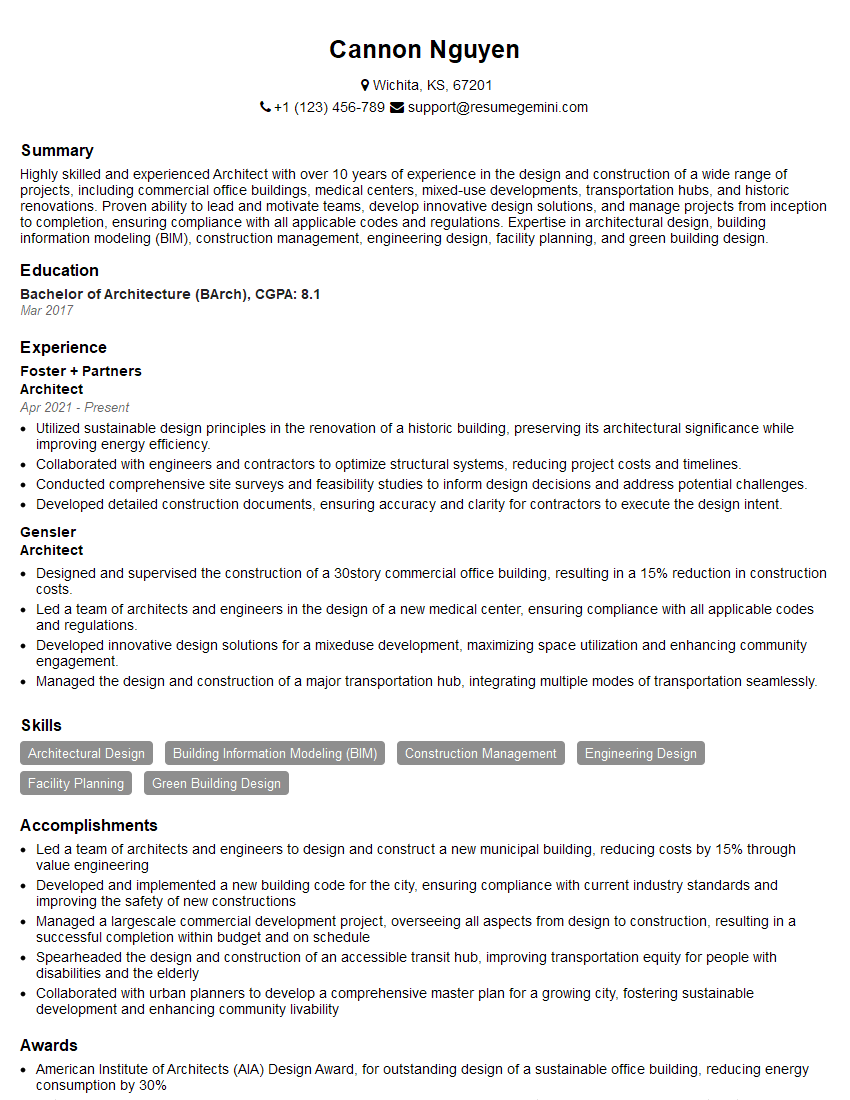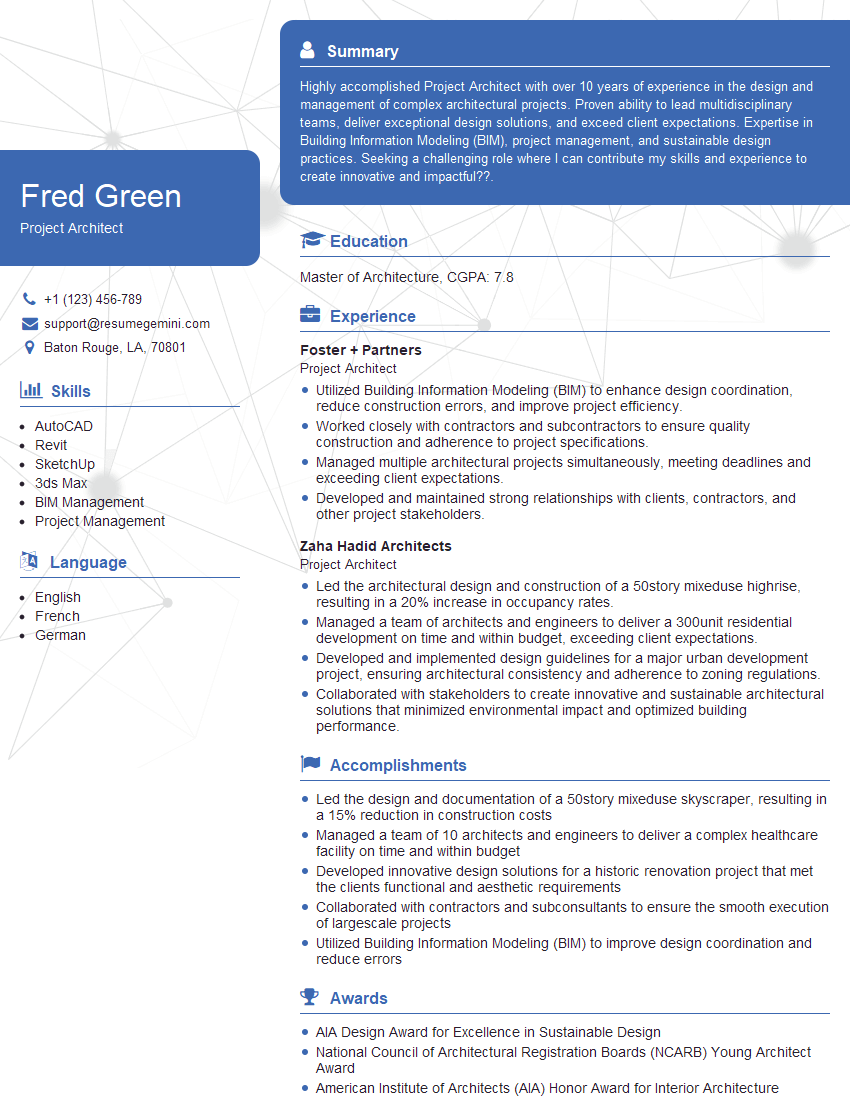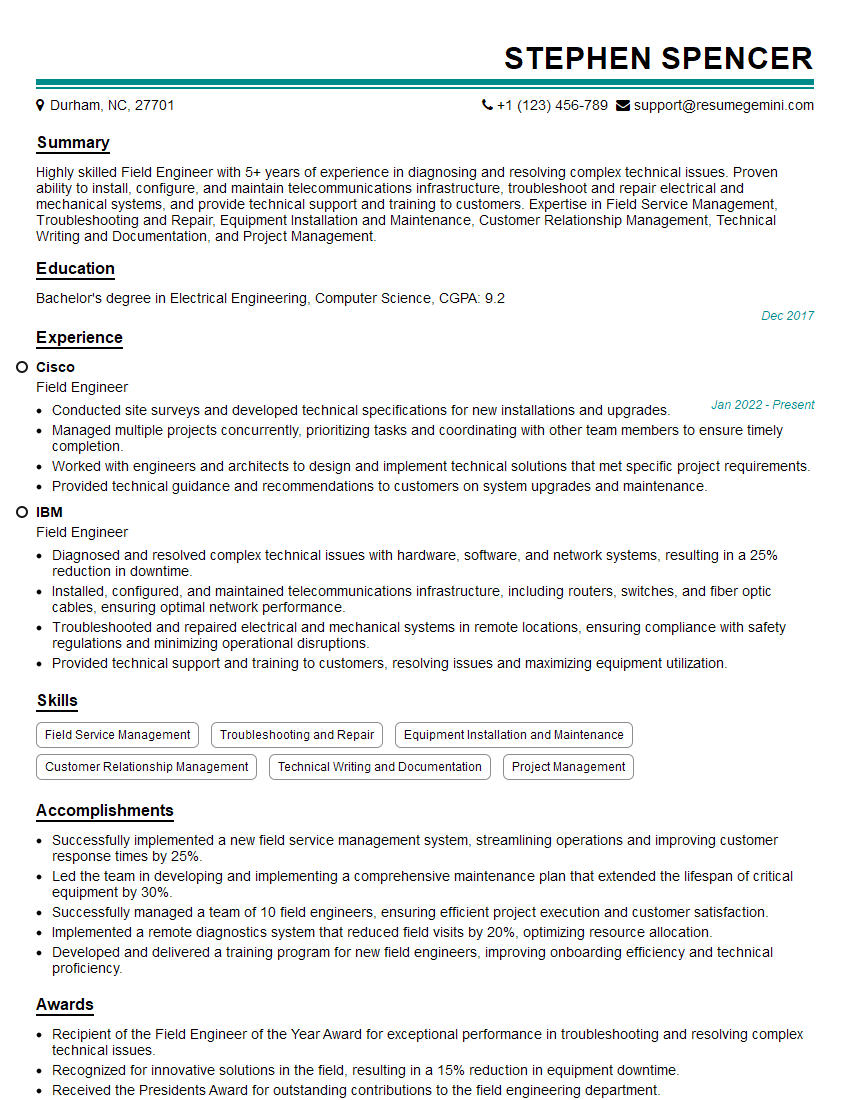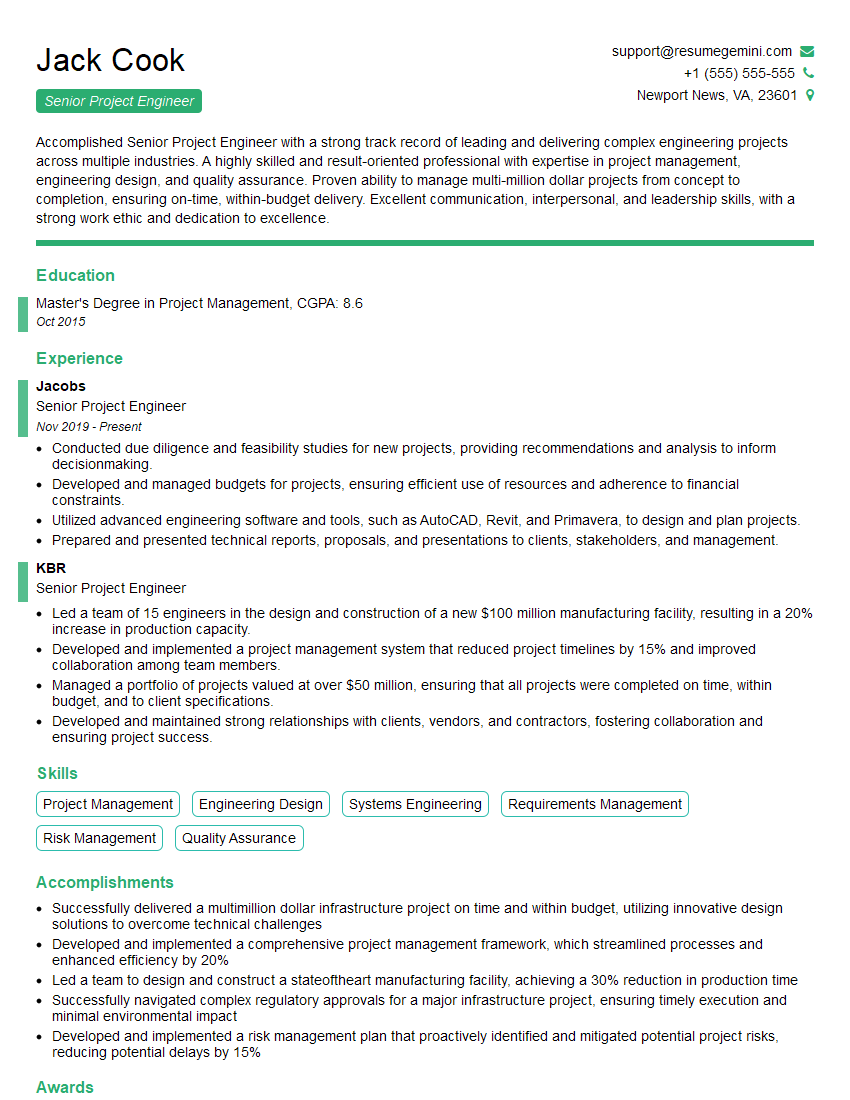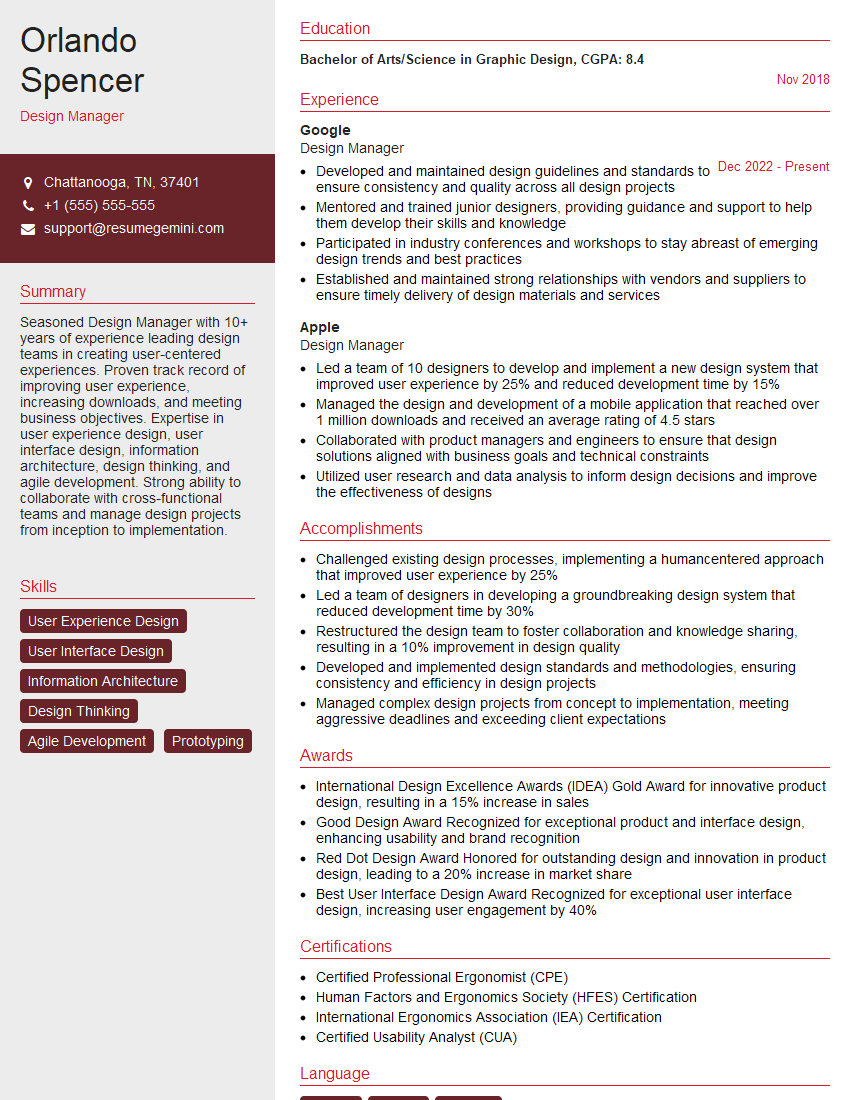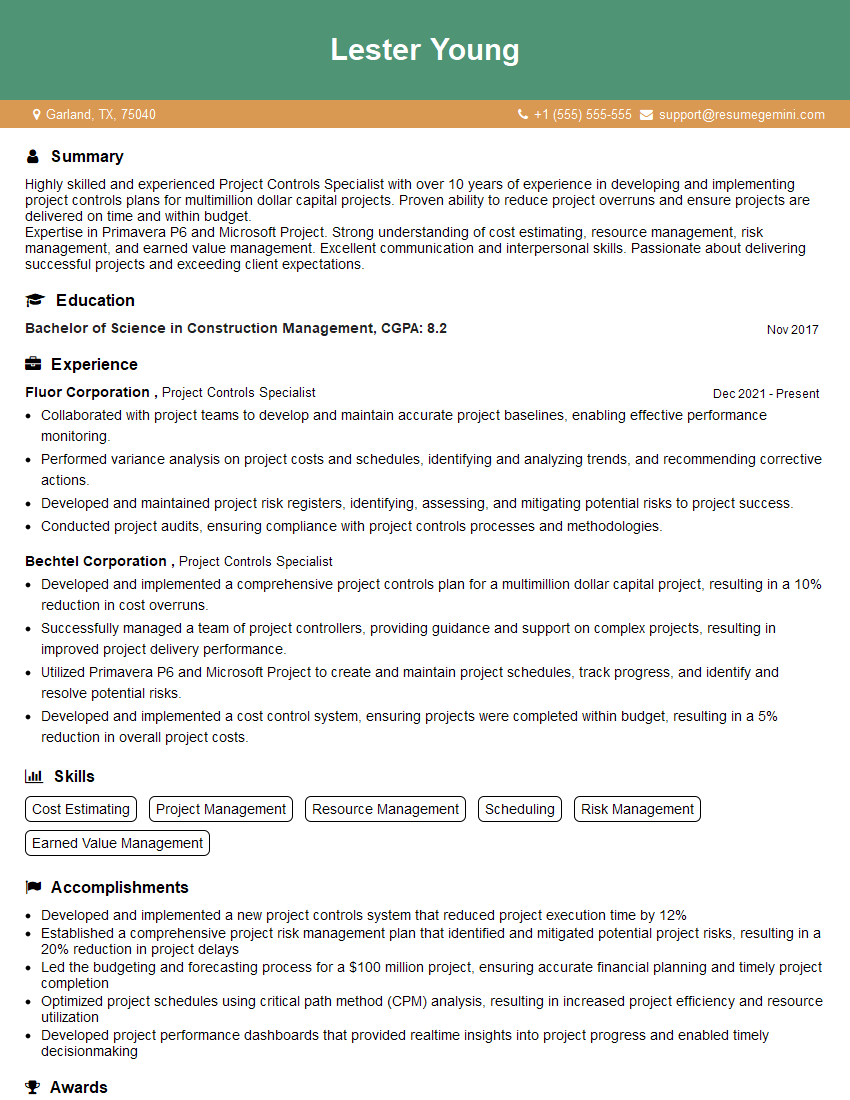Cracking a skill-specific interview, like one for AIA Documents, requires understanding the nuances of the role. In this blog, we present the questions you’re most likely to encounter, along with insights into how to answer them effectively. Let’s ensure you’re ready to make a strong impression.
Questions Asked in AIA Documents Interview
Q 1. Explain the difference between AIA A201 and AIA A101 contracts.
The AIA A201 and AIA A101 are both standard contract forms used in the construction industry, but they serve different purposes and apply to different types of projects. Think of it like this: A101 is the older, more general contract, while A201 is the more modern, detailed version commonly used for larger and more complex projects.
- AIA A101 (Owner-Architect Agreement): This document outlines the agreement between the owner and the architect. It details the architect’s scope of services, payment terms, responsibilities, and the process for handling disputes. It’s essentially a roadmap for the design phase of a project.
- AIA A201 (Owner-Contractor Agreement): This is the more comprehensive contract that governs the relationship between the owner and the general contractor during the construction phase. It covers areas such as payment schedules, change orders, dispute resolution, and the contractor’s responsibilities. It’s a much more in-depth document addressing the intricacies of construction.
In short, A101 focuses on the design phase and the architect’s role, while A201 focuses on the construction phase and the contractor’s role. Often, both documents are used concurrently on a project.
Q 2. Describe the process of submitting a change order using AIA documents.
Submitting a change order under AIA documents is a crucial process to manage project scope changes. It’s not just a simple request; it’s a formal process that protects all parties involved. Here’s a breakdown:
- Initiation: A party (owner, architect, or contractor) identifies the need for a change, formally documenting the reasons and the proposed modifications.
- Proposal: The proposing party submits a written change order proposal to the other parties. This includes detailed descriptions, drawings, specifications, and a cost estimate.
- Negotiation: The parties involved discuss and negotiate the proposed changes, reaching an agreement on the scope, cost, and schedule impacts. This may involve revisions and clarifications.
- Approval: Once agreement is reached, all authorized parties sign and date the change order. This formalizes the agreed-upon modifications.
- Implementation: The contractor implements the approved changes, keeping records of all work performed.
- Payment: The change order becomes a part of the contract, and payment adjustments are made accordingly.
Example: Let’s say unforeseen rock formations are discovered during excavation. A change order would be required to address the extra cost and time needed for removal, with documentation showing the added expenses and revised timeline.
Q 3. What are the key responsibilities of the owner, architect, and contractor as defined in AIA A201?
AIA A201 clearly defines the responsibilities of each party in a construction project. Think of it as a detailed job description for each role:
- Owner: The owner’s responsibilities include providing the necessary site information, making timely payments, reviewing and approving submittals, and generally overseeing the project. They are ultimately responsible for the project’s success and budget.
- Architect: The architect’s responsibilities primarily center around design and administration. This includes preparing drawings and specifications, administering the contract, reviewing shop drawings, and providing project administration services. They act as an independent agent responsible for overseeing that the project meets the owner’s requirements.
- Contractor: The contractor’s key responsibility is to execute the construction work in accordance with the contract documents. This includes coordinating subcontractors, managing the construction schedule, and ensuring the project quality meets the specified standards. They are responsible for the successful execution of the project’s construction.
Each party has specific duties and obligations, and a clear understanding of these roles is vital for a smooth project execution. The failure of one party to meet their obligations can significantly impact the entire project.
Q 4. How are disputes handled under AIA contract documents?
AIA documents provide a structured process for handling disputes. The specific mechanisms depend on the particular contract and potentially any supplementary agreements. However, the general approach often involves:
- Negotiation: The initial step is always to attempt to resolve the dispute through direct negotiation between the parties.
- Mediation: If negotiation fails, mediation is often the next step. A neutral third party helps facilitate communication and find a mutually acceptable solution.
- Arbitration: If mediation fails, arbitration is typically the final recourse before litigation. A neutral arbitrator hears evidence from both parties and renders a binding decision.
- Litigation: Only as a last resort, if the other dispute resolution methods fail, will the parties resort to litigation in court.
The AIA encourages resolving disputes outside of court to reduce time and costs associated with legal battles. The specific clauses regarding dispute resolution will be included in the contract documents.
Q 5. Explain the process for submitting and processing a claim under AIA A201.
Submitting and processing a claim under AIA A201 involves a formal process to ensure transparency and fairness. Here’s a breakdown:
- Notification: The claimant (usually the contractor) must promptly notify the other party (usually the owner) in writing about the potential claim, providing a preliminary description of the issue and the basis for the claim.
- Documentation: The claimant must then submit a formal written claim with comprehensive documentation supporting their request, including relevant contract clauses, supporting evidence such as photos, emails, change orders, and a detailed cost breakdown.
- Review and Response: The other party has a specified period to review the claim and provide a written response. This response might involve acceptance, rejection, or a counter-proposal.
- Negotiation: Further negotiation and discussion are encouraged to reach a mutual agreement. This may involve revised claims or counter-claims.
- Dispute Resolution: If negotiations fail to resolve the claim, the dispute will follow the agreed-upon dispute resolution procedures outlined in the contract (usually involving mediation and/or arbitration).
Timely notification and thorough documentation are critical to a successful claim. Ignoring deadlines or submitting insufficient evidence can weaken a claim significantly. Think of it as building a solid case.
Q 6. What are the typical payment terms outlined in AIA contracts?
AIA contracts typically outline payment terms based on a schedule of values. This is a breakdown of the project’s cost into different phases or components. Payments are then made based on the progress of the work and the value of completed work. Think of it like milestones in a video game, each milestone unlocks a payment.
- Progress Payments: The contractor submits applications for payment along with supporting documentation showing the percentage of work completed in each phase. The owner reviews and approves the applications before releasing payment.
- Retainage: A percentage of each payment is usually withheld by the owner (retainage) as security. This is released after project completion and final inspection. It ensures the contractor completes the project according to the contract. Imagine it like a deposit that ensures the contractor fulfills their promises.
- Final Payment: Once the project is complete, and all inspections and approvals are passed, the final payment, including the released retainage, is made to the contractor.
The specific payment schedule, including the payment terms and percentages, is detailed in the contract itself and is negotiable between the parties.
Q 7. How does the AIA address differing site conditions?
AIA contracts address differing site conditions – unexpected subsurface conditions that differ from what was shown in the contract documents – through a defined process. These conditions can significantly impact the project’s cost and schedule.
- Notification: The contractor must promptly notify the owner and architect if they encounter differing site conditions that materially affect the work.
- Documentation: Detailed documentation, including field reports, photographs, and geotechnical reports, is crucial to support the claim.
- Investigation: The parties may agree on an investigation to determine the nature and extent of the differing site conditions.
- Adjustment: Depending on the contract’s specific language, adjustments to the contract may be made to account for the additional cost and/or time involved in addressing these conditions. This might involve a change order or a claim for additional compensation.
It’s important to note that the contract may stipulate that the contractor is responsible for investigating site conditions prior to bidding. The specifics will vary depending on the contract language and the nature of the differing site conditions. This process is critical in mitigating potential disputes arising from unforeseen circumstances.
Q 8. What are some common problems encountered when using AIA documents, and how can they be avoided?
Common problems using AIA documents often stem from misunderstandings or omissions in the contract. Ambiguous language, incomplete specifications, or a lack of clear communication between parties can lead to disputes. For example, unclear definitions of project scope can result in costly change orders.
- Problem: Disputes over the interpretation of ‘substantial completion’.
- Solution: Define ‘substantial completion’ meticulously in the contract, specifying completion percentages, operational capabilities, and associated documentation requirements.
- Problem: Unclear allocation of risk for unforeseen site conditions.
- Solution: Include detailed site investigation clauses and allocate risk appropriately based on findings. Conduct thorough site visits and include detailed geotechnical reports in the contract documents.
- Problem: Failure to properly document change orders.
- Solution: Use AIA’s Change Order forms and maintain meticulous records of all communications, approvals, and change order impacts on timelines and budgets. Ensure proper signatures and approvals from all relevant parties.
Avoiding these problems requires proactive planning, thorough contract review by legal counsel, and open communication throughout the project lifecycle. Regular meetings and transparent documentation are crucial. Imagine building a house without a blueprint – chaos ensues. Similarly, unclear AIA documents lead to project delays and disputes. Careful preparation and understanding are paramount.
Q 9. Describe the process for obtaining insurance certificates and other required documents under AIA contracts.
Obtaining insurance certificates and other required documents under AIA contracts is a critical process for risk mitigation. Generally, the contractor is responsible for providing evidence of insurance, including general liability, workers’ compensation, and other necessary coverages. The architect usually doesn’t directly handle the procurement, but rather verifies that the correct documentation is provided and meets contract requirements.
The process typically involves:
- Contractor Submission: The contractor submits certificates of insurance (COIs) and other relevant documents to the owner. The contractor should ensure these certificates are current and meet the specified coverage limits outlined in the contract.
- Owner Review: The owner reviews these documents to ensure they meet the contract requirements. This is often managed by the owner’s insurance broker or risk manager.
- Architect Verification: The architect confirms the insurance is in place and is usually informed about the insurance coverage by the owner. However, they generally do not have the direct responsibility of ensuring the issuance of these documents, unless specified differently in the contract.
- Ongoing Monitoring: It’s important to monitor the validity of these documents throughout the project’s duration as they typically have an expiry date.
Failure to maintain valid insurance can halt project progress and lead to legal complications. It’s a shared responsibility. The owner relies on the contractor to submit adequate documentation; the architect serves as a monitor within the limits of their contracted duties.
Q 10. What are the responsibilities of the architect regarding project administration?
The architect’s role in project administration under AIA documents is multifaceted and crucial to the project’s success. They act as a central point of contact, managing information flow and ensuring compliance with contract documents. This includes:
- Reviewing submittals: Architects assess contractor submittals, such as shop drawings, samples, and product data, for compliance with the design intent.
- Managing the schedule: Although not directly responsible for construction scheduling, the architect monitors progress and reports to the owner any significant delays or potential conflicts.
- Approving payments: Based on the progress made, the architect certifies the amount of payment due to the contractor, based on the terms of the contract and observed site progress. This is a very important and sensitive duty.
- Resolving disputes: The architect attempts to mediate disagreements between the owner and contractor.
- Administering contract documents: The architect ensures adherence to the contract’s terms and conditions.
- Documenting decisions: Every decision made must be accurately documented using the relevant AIA forms.
Essentially, the architect serves as a neutral, objective administrator, ensuring fair execution of the contract and protecting the owner’s interests.
Q 11. How does the AIA address delays and extensions of time?
AIA documents address delays and extensions of time through a formal process involving documentation and negotiation. The burden of proving a valid cause for delay often rests with the party claiming the delay. The AIA documents outline procedures for submitting a request for time extension.
The process generally involves:
- Notification: The party experiencing the delay must promptly notify the other party in writing, explaining the cause of the delay and the requested extension.
- Documentation: Supporting documentation is required, such as photos, emails, or reports. This proves the validity of the claim for extension.
- Review: The other party reviews the notification and supporting documentation. The architect may be involved in assessing the legitimacy of the claim.
- Agreement or Dispute Resolution: If both parties agree, the contract is amended. If not, the dispute may be resolved through mediation, arbitration, or litigation.
For instance, if a subcontractor’s delay is due to a material delivery issue outside their control, proper documentation and notification can support a justifiable time extension. But delays caused by the contractor’s own negligence are unlikely to be approved.
Q 12. Explain the process for reviewing and approving submittals according to AIA documents.
Submittal review and approval is a crucial process governed by the AIA documents, aimed at ensuring that all materials and construction elements meet the project’s design specifications and quality standards. The process typically follows these steps:
- Contractor Submittal: The contractor submits shop drawings, samples, product data, and other relevant information to the architect.
- Architect Review: The architect reviews these submittals to ensure they comply with the contract documents and the design intent.
- Approval or Rejection: The architect approves or rejects the submittals. If rejected, the architect typically provides clear reasons for rejection and requests revisions from the contractor.
- Resubmission (if necessary): The contractor resubmits revised submittals for re-review.
- Documentation: The entire process is meticulously documented, including submittal dates, review dates, and approval/rejection decisions.
The architect’s role is impartial. Approvals shouldn’t be given lightly; the architect has a responsibility to the owner to ensure that the materials and work meet the project’s quality standards.
Q 13. Describe the process for handling contractor default under AIA documents.
Handling contractor default under AIA documents is a serious matter with potential legal and financial implications. Default typically occurs when the contractor fails to perform their obligations under the contract, such as failing to complete the work, failing to pay subcontractors, or significant delays without valid cause. The process is governed by the contract and can vary depending on the specific circumstances.
The steps generally include:
- Notice of Default: The owner sends the contractor a formal written notice, detailing the default and providing a reasonable opportunity to cure the default.
- Cure Period: The contractor has a specified period to remedy the situation.
- Failure to Cure: If the contractor fails to cure the default within the specified period, the owner may pursue various remedies.
- Termination: The owner may terminate the contract. This requires strict adherence to the contract’s termination clause. The owner might choose to finish the project using other contractors.
- Legal Action: Depending on the severity and cost, the owner might initiate legal action to recover damages incurred by the contractor’s default.
Careful documentation is crucial. Maintaining records of the contractor’s performance, communications, and notices is essential should litigation become necessary. This is a complex process, and legal advice is crucial.
Q 14. How does the AIA address liens and lien waivers?
AIA documents address liens and lien waivers to protect both the owner and contractors from financial risk. A lien is a legal claim against property to secure payment for services or materials. A lien waiver is a document that releases the property from the lien.
The process typically involves:
- Proper Payment Procedures: The contract specifies a payment process which includes regular payments to contractors and subcontractors. Timely payments greatly reduce the likelihood of liens.
- Lien Waivers: Subcontractors provide lien waivers upon receiving payment, confirming that they have been paid in full. General contractors also provide lien waivers to the owner upon receiving payments, showing that they have paid their subcontractors.
- Prompt Payment: The owner’s prompt payment to the general contractor, according to the contract’s payment terms, reduces the risk of liens.
- Dispute Resolution: If a payment dispute arises, clear communication, documentation, and prompt resolution are critical to preventing liens.
- Legal Counsel: If liens are filed, legal counsel is necessary to resolve the issue.
AIA documents emphasize the importance of properly executed lien waivers and timely payments to minimize the risk of liens. A well-structured payment process, with carefully drafted contracts and clear communication, is key.
Q 15. What are the different types of AIA contracts and when would you use each?
AIA (American Institute of Architects) offers a range of contract documents tailored to different project types and relationships. The most commonly used are those within the A-series. The choice depends heavily on the project’s complexity, the owner’s involvement, and the nature of the contractor’s responsibilities.
- AIA A101: This is a standard owner-contractor agreement for a stipulated sum (fixed price). It’s suitable for projects with well-defined scopes where the contractor agrees to complete the work for a predetermined price. Think of a straightforward residential renovation with clear specifications.
- AIA A201: This is the more comprehensive General Conditions of the Contract for Construction. It’s used as a supplement to other AIA contract documents, often paired with the A101 or A111. It defines the rights, responsibilities, and processes for the owner and the contractor throughout the project lifecycle, including payment terms, change orders, and dispute resolution.
- AIA A111: This is another owner-contractor agreement, but for a cost-plus-fee arrangement. This is ideal for projects where the scope isn’t fully defined initially, or where flexibility and potential design changes are expected, such as complex commercial construction or research facilities.
- AIA B101: This is a shorter, simpler owner-contractor agreement intended for smaller projects where a fixed price is agreed upon. It’s less detailed than the A101.
Choosing the correct contract is crucial. Using an inappropriate document can lead to disputes and costly legal battles. A knowledgeable attorney specializing in construction law is highly recommended for contract selection and review.
Career Expert Tips:
- Ace those interviews! Prepare effectively by reviewing the Top 50 Most Common Interview Questions on ResumeGemini.
- Navigate your job search with confidence! Explore a wide range of Career Tips on ResumeGemini. Learn about common challenges and recommendations to overcome them.
- Craft the perfect resume! Master the Art of Resume Writing with ResumeGemini’s guide. Showcase your unique qualifications and achievements effectively.
- Don’t miss out on holiday savings! Build your dream resume with ResumeGemini’s ATS optimized templates.
Q 16. Explain the concept of substantial completion according to AIA A201.
Substantial completion, as defined by AIA A201, is a key milestone signifying that the project is functionally useable. It doesn’t mean the project is 100% finished; rather, it indicates that the work is sufficiently complete to allow the owner to occupy or use the building for its intended purpose. Minor, incomplete items may still exist, but they don’t prevent the owner from enjoying the building’s essential functions.
Imagine a new office building. Substantial completion would mean the building is structurally sound, has operational HVAC and electrical systems, and the majority of interior finishes are in place. A few minor punch list items, like touch-ups to paint or installing missing light fixtures, might still need to be completed, but these won’t prevent the company from moving in and starting operations. This is when the Owner can issue a Certificate of Substantial Completion.
Q 17. How are payments processed and certified under AIA contract documents?
Payment processing under AIA contracts involves a systematic approach, usually involving the submission of applications for payment by the contractor and their subsequent review and certification by the architect (or other designated representative).
- Contractor Submits Application: The contractor prepares and submits a detailed application for payment, outlining the completed work, materials supplied, and the payment requested, often with supporting documentation like invoices and payrolls.
- Architect Reviews and Certifies: The architect then reviews the application, verifies the work performed based on site visits and contract documents, and issues a certificate for payment reflecting the amount the owner should pay. This certification isn’t a guarantee of the work’s quality, but rather a confirmation that the work described has been performed to the contract.
- Owner Makes Payment: Upon receiving the certificate, the owner pays the contractor the certified amount. Any disagreements on the amount certified should be addressed through dispute resolution mechanisms outlined in the contract.
It’s essential for accurate and timely submission of applications, supporting documentation, and a clear understanding of payment schedules to ensure a smooth payment process. Delays or discrepancies can lead to disputes and potential cash flow issues for the contractor.
Q 18. What are some common clauses in AIA documents that impact risk allocation?
Several clauses in AIA documents significantly influence risk allocation between the owner and the contractor. These clauses can be crucial in determining who bears responsibility for delays, damages, or unforeseen circumstances.
- Changes in the Work (A201): This clause outlines the process for managing changes to the original scope of work. It dictates how change orders are initiated, reviewed, approved, and priced, impacting which party bears the cost and time implications of changes.
- Insurance and Bonds (A201): This section addresses required insurance policies and surety bonds (like performance bonds and payment bonds). These instruments allocate the risk of financial loss, non-performance, or contractor default.
- Differing Site Conditions (A201): This crucial clause addresses unexpected subsurface or site conditions that differ materially from those indicated in the contract documents. It typically establishes a process for determining responsibility and compensation for extra work or delays caused by such discrepancies.
- Warranty (A201): The warranty clause assigns responsibility for defects or failures in the constructed work over a specified period. This dictates who is accountable for rectifying issues that emerge after project completion.
A thorough understanding of these risk allocation clauses is paramount. Contractors and owners should carefully review these clauses with legal counsel to ensure the risk profile aligns with their respective interests and risk tolerance.
Q 19. Explain the concept of warranty under AIA documents.
Warranty in AIA documents covers the contractor’s responsibility for rectifying defects in their work for a specified period after substantial completion. It essentially guarantees the quality of the workmanship and materials for a certain timeframe.
A typical warranty clause might cover latent defects (hidden issues that weren’t apparent during the project) and patent defects (obvious flaws). The duration of the warranty varies depending on the specific contract and the type of work; for example, roofing warranties are often shorter than those for structural components. The contractor’s obligation under the warranty clause usually includes repairing or replacing defective work at their expense within a reasonable timeframe.
Understanding the scope and duration of the warranty is vital for both the owner and contractor. The owner needs to know what’s covered in case of problems, and the contractor should factor potential warranty costs into their bidding and project planning.
Q 20. How are final payments handled under AIA contract documents?
Final payment under AIA contracts typically occurs after substantial completion and after all punch list items are completed. The process involves several steps.
- Completion of Punch List: The contractor addresses all outstanding items identified during the inspection of the project (the punch list). This usually involves minor corrections or adjustments.
- Final Inspection: Once the punch list is complete, a final inspection is conducted to verify the completion of all work according to the contract documents.
- Application for Final Payment: The contractor submits an application for final payment with any necessary documentation such as closeout documents and waivers.
- Release of Retainage: Usually, the owner retains a percentage of the total payment (retainage) until project completion as security. Once the project is finalized, this retainage is released to the contractor.
- Final Certificate of Payment: The architect issues a final certificate of payment, confirming that the project has been completed satisfactorily, and the owner makes the final payment to the contractor.
The final payment process is often subject to a timeframe defined in the contract. Clear communication and documentation throughout the process are critical to ensure timely and accurate payment. Retention of funds, if any, protects the owner from any problems arising post-completion.
Q 21. What are some common reasons for disputes on construction projects involving AIA contracts?
Disputes on construction projects involving AIA contracts often stem from ambiguities or disagreements related to several key aspects of the project.
- Scope of Work: Disputes can arise if there are ambiguities or misunderstandings concerning the extent of the work included in the original contract. For example, what constitutes ‘finishing’ or the exact specifications of materials.
- Change Orders: Disagreements frequently occur on the proper pricing or implementation of change orders, especially regarding the impact on time and cost.
- Differing Site Conditions: Unexpected conditions uncovered during construction can be a major source of dispute, often causing delays and cost overruns.
- Payment Disputes: Disputes over the amount owed or the timing of payments are common, often due to discrepancies in the contractor’s application for payment or the architect’s certification.
- Warranty Claims: Disagreements regarding the scope and duration of the warranty, as well as responsibility for rectifying defects, can lead to costly litigation.
To minimize disputes, thorough planning, clear communication, and detailed contract documentation are essential. Construction projects require proactive problem-solving, and dispute resolution mechanisms outlined in the contract, such as mediation or arbitration, should be used to avoid costly and time-consuming litigation.
Q 22. How do you interpret the language of an AIA contract?
Interpreting AIA contract language requires a deep understanding of construction law and standard industry practices. It’s not just about reading the words; it’s about understanding the context, the intent behind each clause, and how it interacts with other parts of the agreement. I approach this by first carefully reviewing the entire document to understand the overall project scope and the relationship between the parties. Then, I analyze each clause individually, looking for ambiguities and potential conflicts. I consider the specific circumstances of the project, relevant case law, and industry standards to interpret the language accurately and fairly. For instance, understanding the difference between ‘time is of the essence’ clauses and those which are more flexible is crucial in determining potential liabilities for schedule delays. This requires meticulous attention to detail and a thorough understanding of construction terminology.
Think of it like deciphering a legal puzzle. Each clause is a piece, and the goal is to assemble them correctly to understand the complete picture. Understanding the subtle nuances of language, like the difference between ‘shall’ and ‘may,’ is vital for accurate interpretation. I always err on the side of caution, seeking clarification whenever ambiguity exists. If there’s a dispute, my approach will prioritize using the contract’s language as the primary source of resolution.
Q 23. What are some best practices for managing documents using AIA standards?
Managing AIA documents effectively is paramount for successful project execution. Best practices include using a centralized, easily accessible document management system, whether it’s a cloud-based platform or a robust internal server. This ensures all stakeholders have access to the most current versions. Version control is crucial; utilizing a system that tracks changes and revisions allows for easy identification of updates and prevents confusion caused by outdated documents. Regularly backing up all documents safeguards against data loss. A clear document naming convention (e.g., Project Name_Document Type_Revision Number) is critical for organization and retrieval.
Furthermore, a well-defined process for distributing and approving documents is vital. This involves setting up clear workflows for review, approval, and distribution, ensuring timely communication and preventing delays. Regular audits of the document management system help maintain its integrity and identify potential issues. Finally, training all project team members on the document management system and the established procedures ensures everyone understands their responsibilities and adheres to best practices. This structured approach minimizes the risk of miscommunication and disputes, leading to a smoother and more efficient project.
Q 24. How does AIA address sustainability and environmental concerns?
AIA acknowledges the increasing importance of sustainability and environmental concerns through the inclusion of specific clauses and the development of supplementary guides within its documents. While not explicitly stated in every contract, many forms allow for the incorporation of sustainable design and construction practices. For example, some contracts encourage the use of sustainable materials or energy-efficient technologies. Furthermore, AIA publishes guides and resources explicitly focused on sustainable practices. These guides provide direction on incorporating environmentally conscious principles into projects, promoting responsible resource management and reducing environmental impact.
In practice, the incorporation of sustainability often relies on the negotiation and agreement between the owner and the contractor. This could involve specifying targets for reducing carbon emissions, utilizing recycled materials, or adhering to certain environmental standards. The AIA documents serve as a framework, allowing the parties to outline specific requirements and expectations regarding sustainable practices within the broader context of the contract. It’s a collaborative effort to balance project goals with environmental responsibility.
Q 25. Describe your experience in interpreting and applying specific AIA contract clauses.
My experience with AIA contract clauses involves extensive work with clauses related to payment, change orders, and dispute resolution. For instance, I’ve interpreted the payment provisions in AIA A201, understanding the nuances of progress payments, retainage, and the process for submitting and approving applications for payment. In several projects, I’ve helped navigate complex change orders, ensuring that they are properly documented, priced, and authorized in accordance with the contract. I have expertise in understanding the implications of various dispute resolution clauses, such as mediation and arbitration, helping my clients anticipate and effectively navigate potential conflicts.
For example, on a recent project, a significant change order arose. Through careful examination of AIA A201’s change order clause, we were able to successfully negotiate a fair adjustment to the contract price, avoiding costly litigation. Understanding the specific language about time extensions and the potential impact on the overall project schedule was critical. My thorough analysis prevented unnecessary delays and financial disputes. Another instance involved clarifying ambiguities in the definition of ‘substantial completion’ to avoid disagreements between the owner and contractor at the project’s end.
Q 26. Explain how you have used AIA documents to resolve conflict or prevent disputes.
I’ve effectively utilized AIA documents to resolve conflicts and prevent disputes by proactively addressing potential issues before they escalate. By utilizing the contract’s specific clauses and dispute resolution mechanisms, I’ve fostered collaborative problem-solving and averted costly litigation. A key strategy is proactively engaging all parties in open communication, using the AIA documents as a common reference point for resolving discrepancies or ambiguities. If a dispute does arise, the structured approach of the AIA documents provides a clear framework for negotiations and alternative dispute resolution.
In one instance, a disagreement emerged about the interpretation of a technical specification. By referring to the relevant clause in the AIA document and engaging in open dialogue, we clarified the ambiguity, arriving at a mutually agreeable solution. In another case, I helped mediate a dispute regarding a delay claim, utilizing the AIA A201’s guidelines on time extensions and cost adjustments to reach a fair settlement. By thoroughly understanding and applying the specific clauses, I’ve consistently helped guide my clients towards amicable resolutions, reducing costs and preserving working relationships.
Q 27. How do you stay updated on changes and revisions to AIA documents?
Staying updated on AIA document changes is critical for maintaining my expertise. I subscribe to AIA’s publications and announcements to receive notifications about revisions and new releases. I actively participate in industry conferences and workshops where updates to the AIA documents are frequently discussed and explained. Professional development courses focusing on AIA contracts provide valuable insights into recent changes and their practical applications. Furthermore, I regularly review online resources and legal databases to keep abreast of relevant case law that interprets and clarifies the AIA documents.
Maintaining a network of colleagues and industry professionals who are also AIA experts helps to share knowledge and stay informed. This continuous learning approach ensures that my understanding of the AIA documents remains current and relevant, allowing me to provide the most accurate and effective legal advice.
Q 28. Describe your experience working with various AIA contract forms in different project types.
My experience spans various AIA contract forms across diverse project types, including residential, commercial, and public works. I’ve worked extensively with AIA A201 (General Conditions of the Contract for Construction), which is the cornerstone for many projects, along with other complementary forms like A101 (Owner-Contractor Agreement), A701 (Instructions to Bidders), and G701 (Change Order). I have experience adapting these documents to suit the specific needs and complexities of each project, addressing unique challenges related to different project delivery methods (design-bid-build, design-build, construction management at risk).
For example, on a large-scale commercial project, the use of AIA A201, along with its associated supplementary documents, was crucial in managing the complex relationships between multiple contractors and subcontractors. In contrast, on a smaller residential project, a simplified version of the A201 was used, tailored to the specific needs and scale of the project. This demonstrates my ability to select and apply the appropriate AIA documents based on project complexity and risk. My experience ensures that the chosen contractual framework effectively protects the interests of all parties involved, leading to a smoother and more successful project.
Key Topics to Learn for AIA Documents Interview
- AIA Contract Documents Overview: Understanding the purpose and structure of AIA documents, including the different contract types and their applications.
- Key Clauses & Provisions: Analyzing critical clauses related to payment schedules, change orders, and dispute resolution. Practical application: Identifying potential risks and liabilities within a contract.
- Owner-Architect Agreements (AIA A101/A101™-2017): Focus on responsibilities, payment procedures, and termination clauses. Practical application: Understanding how to manage client expectations and mitigate potential conflicts.
- Owner-Contractor Agreements (AIA A201/A201™-2017): Detailed understanding of payment mechanisms, project scheduling, and dispute resolution processes. Practical application: Effectively navigating contract administration and resolving construction disputes.
- Change Order Management: Processes for submitting, reviewing, and approving change orders, including cost and schedule implications. Practical application: Preparing and negotiating change orders effectively.
- Claims and Dispute Resolution: Understanding AIA document provisions for handling claims and disputes, including mediation and arbitration. Practical application: Identifying and addressing potential claims early in the project.
- Insurance and Bonding Requirements: Thorough understanding of insurance and bonding requirements within the AIA documents. Practical application: Ensuring appropriate coverage and protection for all parties involved.
- Project Closeout Procedures: Familiarization with the procedures for project closeout according to AIA documents. Practical application: Successfully completing a project and ensuring final payment.
Next Steps
Mastering AIA Documents is crucial for career advancement in architecture, construction management, and related fields. A strong understanding of these documents demonstrates professionalism, risk management skills, and a commitment to project success. To significantly enhance your job prospects, create an ATS-friendly resume that highlights your relevant skills and experience. ResumeGemini is a trusted resource to help you build a compelling and effective resume. Examples of resumes tailored to showcase AIA Documents expertise are available, giving you a head start in crafting your perfect application.
Explore more articles
Users Rating of Our Blogs
Share Your Experience
We value your feedback! Please rate our content and share your thoughts (optional).
What Readers Say About Our Blog
Hi, I represent an SEO company that specialises in getting you AI citations and higher rankings on Google. I’d like to offer you a 100% free SEO audit for your website. Would you be interested?
Hi, I represent an SEO company that specialises in getting you AI citations and higher rankings on Google. I’d like to offer you a 100% free SEO audit for your website. Would you be interested?
Dear Sir/Madam,
Do you want to become a vendor/supplier/service provider of Delta Air Lines, Inc.? We are looking for a reliable, innovative and fair partner for 2025/2026 series tender projects, tasks and contracts. Kindly indicate your interest by requesting a pre-qualification questionnaire. With this information, we will analyze whether you meet the minimum requirements to collaborate with us.
Best regards,
Carey Richardson
V.P. – Corporate Audit and Enterprise Risk Management
Delta Air Lines Inc
Group Procurement & Contracts Center
1030 Delta Boulevard,
Atlanta, GA 30354-1989
United States
+1(470) 982-2456
